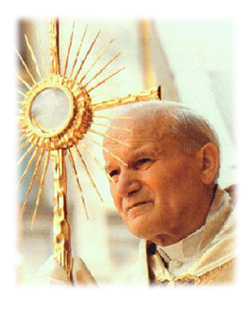We are in a beautiful moment right now, liturgically speaking, suspended between the Transfiguration of the Lord and the Assumption of the Blessed Virgin Mary. I love that these two great feasts are so close to each other, and there is an incredible amount of spiritual richness to be gained from reflecting on them, both individually and the deep connection they have to each other. I won’t be able to even scratch the surface in this little blog post, but here are a few thoughts that I’ve been pondering.
In our gospel today, Jesus tells us:
“Whoever serves me must follow me,
and where I am, there also will my servant be.”
Jn. 12:24
So we’re supposed to follow the Lord. Most often this is interpreted to mean taking up our crosses and uniting our earthly sufferings to the Lord’s Passion. But today I was taken even deeper. If we are faithful servants, we will be where He is. Yes, Jesus asks us to follow Him — but where did He go? Where is He? Living and glorious in heaven. United, body and soul, with the Father, the Holy Spirit, the Blessed Virgin Mary, and the whole company of heaven. What does this have to do with the Transfiguration and the Assumption, you ask? In the Transfiguration, we are given a glimpse of this heavenly glory, a glory not meant for Christ alone, but a glory destined also for us, as revealed by the Assumption of Our Lady.
In the Office of Readings, St. Anastasius tells us exactly what the Transfiguration means for us:
“Jesus goes before us to show us the way, both up the mountain and
into heaven, and — I speak boldly — it is for us now to follow him with all speed, yearning for the heavenly vision that will give us a share
in his radiance, renew our spiritual nature and transform us into
his own likeness, making us for ever sharers in his Godhead
and raising us to heights as yet undreamed of.”
So the glory of heaven (foreshadowed by the Transfiguration) is when we are so completely transformed into the very likeness of God that we share in His own radiance, and are united with Him, body and soul, in the love and life of the Trinity itself. But in preparation to follow Jesus to this heavenly glory, we need to begin the process of our personal transfiguration here on earth, to enter into eternal life now. Pope Emeritus Benedict XVI re-affirms this in his beautiful encyclical, Sacramentum Caritatis:
“…’eternal life’ begins in us even now, thanks to the
transformation effected in us by the gift of the Eucharist.” 70“The Eucharist … makes possible, day by day,
the progressive transfiguration of all those called by grace
to reflect the image of the Son of God.” 71
And he uses even stronger language earlier on, saying that the Eucharist introduces
“a radical change, a sort of ‘nuclear fission,’ … a change meant
to set off a process which transforms reality, a process
leading ultimately to the transfiguration of the entire world.” 11
This is the power of the Lord’s presence in the Eucharist! Radical change. Process. Transfiguration. And this is what we are called to embrace in our daily lives, striving to “serve and follow” so that we can “be where God is” forever. Essentially, the Eucharist is the food that helps us grow spiritually and become holy by learning how to live the way God lives, how to live eucharistically. And it does this because we are taking God into our very bodies, and taking on the way He lives.
And no one did this more than our Lady. St. John Paul II tells us in his encyclical letter Ecclesia de Eucharistia that there is “nothing greater than [Mary’s] spirituality for helping us to experience the mystery of the Eucharist. The Eucharist has been given to us so that our life, like that of Mary, may become completely a Magnificat!” Her entire life was a joyful fiat, or as the pope says, a “sheer abandonment” to the will of God, which anticipated Christ’s surrender in the garden: “Not my will, Father, but yours be done.” By her example, Mary teaches us to lead lives of total self-gift, full of praise and thanksgiving, and centered on the Eucharist:
“… is not the enraptured gaze
of Mary as she contemplated the face of the newborn Christ and cradled him
in her arms that unparalleled model of love which should inspire us every time we receive Eucharistic communion?”
Mary lived solely to love and serve the Lord. And she was rewarded for her constant “yes,” for her deep sharing in Jesus’ Passion and death, by being taken up into heaven, body and soul, to live in total union with God. Mary’s life shows us how we ought to live, and her Assumption reveals the Father’s plan for each of us. As we see in the Catechism: “We are called to share in the life of the Blessed Trinity, here on earth in the obscurity of faith, and after death in eternal light” (#265). God the Father longs to bring each of us, as His adopted children, into the very life of the Trinity, just as He did Mary, to live united with Him forever in glory.
Our goal is to enter fully into this heavenly glory of God, seen at the Transfiguration; the Assumption shows us how this will happen — but we have to allow the process of transformation to begin here on earth. The best way we can do this is by asking our Lady to help us make the Eucharist the center of our lives. We should constantly be inviting the Lord to come into our hearts as Mary did, asking Him to increase our longing for His presence in the Eucharist, to continually reveal His love for us, and to remake us in His likeness.
And so, as we live and breathe in the Lord’s grace on our way from one glorious feast to the next, let us ask our Lady to obtain for us the desire and the grace to begin our heaven now, to continually say yes to our own progressive transfiguration by seeking to encounter the Lord more and more in the Blessed Sacrament, and to fully embrace this process of becoming holy by learning how to live eucharistically. Consciously striving for this, through the intercession of our Mother in heaven, may we one day hear the Lord say to each of us, “Well done, good and faithful servant … enter into your Master’s joy”(Mt. 25:21).
“All of us, gazing on
the Lord’s glory
with unveiled faces,
are being transformed
from glory to glory
into his very image
by the Lord who
is the Spirit.”
2 Cor. 3:18



